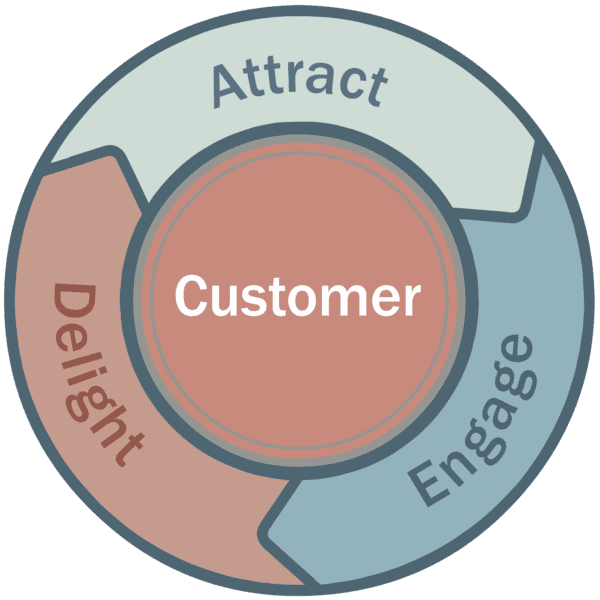 Inbound marketing is all about the customer.
Inbound marketing is all about the customer.
Compared to the traditional outbound marketing process (buying ads, email lists, and leads), the core of inbound marketing is providing value for your prospects, giving customers what they’re looking for and strengthening relationships. The focus has shifted from market-centric to customer-centric.
If you’re still a little hazy on inbound and how it works for your business, you’ve come to the right place. We’ve created this simple introductory guide to inbound marketing methodology for you to learn more about how you can find marketing success in the digital age.
The Stages of Inbound
Just like marketing, HubSpot (the company that created the inbound methodology) is evolving and growing. At INBOUND 2018, HubSpot threw a retirement party for the inbound funnel, introducing the new flywheel framework in its place.

Overall, the flywheel is the natural development of a person who transforms from a stranger to your business into a customer and eventual promoter of your brand. There are three main stages to the inbound flywheel methodology: Attract, Engage, and Delight. At each phase, you can establish specific tactics and strategies to help people move from one point to the next.
⇒ Attract
Driving website traffic is a fundamental aspect of inbound. It’s not just that you want to attract strangers to your website, though – you want to attract the right prospects. The people who connect with your message are more likely to become leads.
Efforts like brand awareness, UX design, and content marketing are all key players in this stage.
⇒ Engage
Engagement often occurs once you’ve successfully attracted visitors to your site. People at this stage are usually experiencing some form of consideration, evaluation or rationalization regarding your products and services.
Implement social proof, customer reviews, email marketing, and case studies to gather useful contact information and start reaching buyers in this phase.
⇒ Delight
Remember, not everyone is sales-ready. Most people aren’t ready to make a purchase decision the minute they engage, which means you need to nurture them. With the delight stage, customer service will make or break you.
Use support materials like customer surveys, recommendation decks, and a customer knowledge base to provide ongoing delivery and offer service that continuously exceeds expectation.
Once a buyer moves through all three stages, the process begins again. It is important to note that every prospect is influenced by different factors that impact their buyer’s journey. It’s likely that no lead will move from cycle to cycle, in the same way, each time.
Reach People Where They’re At
The inbound methodology is about creating and sharing valuable, relevant messages to attract the right strangers, making them potential leads worth trying to convert. You can use specific content strategies at each stage to turn visitors into promoters:
- Creation: Your message should be highly personalized to both your buyer personas and which stage of the buyer’s journey they’re at – clueless, curious, or serious.
- Distribution: While content creation is essential, distribution is equally important. For every hour you spend on creating content, you should spend the same amount of time distributing it.
- Tracking: You must track and analyze your content regularly. There are several metrics you can use to optimize your content process. To start, we suggest you track number of visits and leads generated.
Using the inbound marketing methodology, you will be able to refine your content to publish in the exact right place at the right time to attract your ideal audience to your website.
Editor’s Note: This article June was initially published in June 2017 and has been updated for clarity and accuracy.
